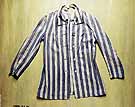
|
|
|

|

|

|

|
|
Click on an image to see a larger, more detailed picture.
|
|
|
|
|
| 1945: Liberation and Rebuilding |

|
pg. 605 |

|
|
|
|
| |
 This jacket belonged to William Luksenburg, a Holocaust survivor. After his parents were deported to Auschwitz in 1942, Luksenburg was sent to one of Auschwitz's satellite camps. By January 1945 he had been shipped to Flossenbürg and then Regensburg, Germany, where he worked on the railroad. As the end of the war drew near, Luksenburg survived a death march. An American soldier who found Luksenburg's jacket and buried it to avoid the spread of disease dug it up four months later and kept it as a "souvenir."
This jacket belonged to William Luksenburg, a Holocaust survivor. After his parents were deported to Auschwitz in 1942, Luksenburg was sent to one of Auschwitz's satellite camps. By January 1945 he had been shipped to Flossenbürg and then Regensburg, Germany, where he worked on the railroad. As the end of the war drew near, Luksenburg survived a death march. An American soldier who found Luksenburg's jacket and buried it to avoid the spread of disease dug it up four months later and kept it as a "souvenir."
Photo: United States Holocaust Memorial Museum Photo Archive
|
 Nazi exploitation of their victims extended beyond plundered hair and dental gold. It included even the ashes of the murdered. At some camps, random ashes were collected in urns and sold to grieving survivors as the remains of specific loved ones. This urn and barrel of ash were discovered at the Flossenbürg, Germany, concentration camp, where commandant Hans Vogel made tidy sums from the deception.
Nazi exploitation of their victims extended beyond plundered hair and dental gold. It included even the ashes of the murdered. At some camps, random ashes were collected in urns and sold to grieving survivors as the remains of specific loved ones. This urn and barrel of ash were discovered at the Flossenbürg, Germany, concentration camp, where commandant Hans Vogel made tidy sums from the deception.
Photo: Drew University Center for Holocaust Study
|
 These Polish women partisan soldiers had been captured by the Germans in the battle for Warsaw in the fall of 1944. The women were liberated from German prisoner-of-war camps by Polish troops near Emden, Germany. Some of the liberators found their wives here. The Germans recognized some rights for West European soldiers who became POWs. The Nazis treated gentile partisans less well, and accorded no rights at all to Jewish civilians.
These Polish women partisan soldiers had been captured by the Germans in the battle for Warsaw in the fall of 1944. The women were liberated from German prisoner-of-war camps by Polish troops near Emden, Germany. Some of the liberators found their wives here. The Germans recognized some rights for West European soldiers who became POWs. The Nazis treated gentile partisans less well, and accorded no rights at all to Jewish civilians.
Photo: Corbis-Bettmann
|
|

|

|

|

|
 April 14, 1945: Swedish diplomat Count Folke Bernadotte negotiates the repatriation of 423 Danish Jews held at the Theresienstadt, Czechoslovakia, camp/ghetto.
April 14, 1945: Swedish diplomat Count Folke Bernadotte negotiates the repatriation of 423 Danish Jews held at the Theresienstadt, Czechoslovakia, camp/ghetto.
|
 April 14, 1945: American troops reach Gardelegen, Germany, and discover the charred corpses from the previous day's massacre of Jews.
April 14, 1945: American troops reach Gardelegen, Germany, and discover the charred corpses from the previous day's massacre of Jews.
|
 April 15, 1945: British troops reach the Bergen-Belsen, Germany, concentration camp and find 60,000 survivors and 27,000 unburied corpses. Following liberation, starvation and typhus will claim about 500 inmates every day for ten days; See April 15-17, 1945.
April 15, 1945: British troops reach the Bergen-Belsen, Germany, concentration camp and find 60,000 survivors and 27,000 unburied corpses. Following liberation, starvation and typhus will claim about 500 inmates every day for ten days; See April 15-17, 1945.
|
 April 15, 1945: British troops close on Bremen and Hamburg, Germany.
April 15, 1945: British troops close on Bremen and Hamburg, Germany.
|
 April 15, 1945: Soviet forces are 35 miles east of Berlin and 60 miles east of Dresden, Germany.
April 15, 1945: Soviet forces are 35 miles east of Berlin and 60 miles east of Dresden, Germany.
|
|
|
|
|
| 1945: Liberation and Rebuilding |

|
pg. 605 |

|
|
The Holocaust Chronicle
© 2009 Publications International, Ltd.
|
|
